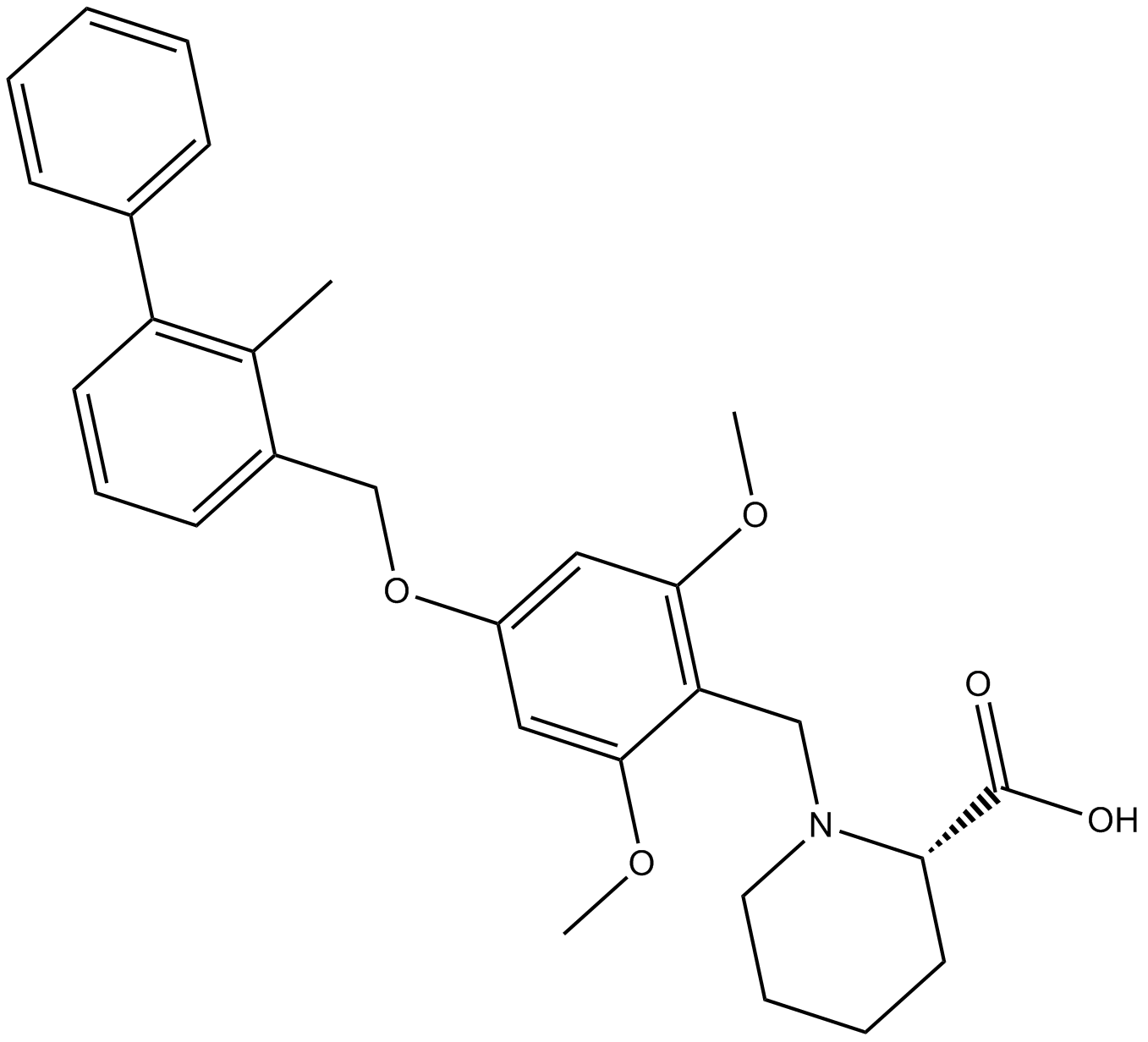PD-1/PD-L1 inhibitor 1 (BMS-1) (Synonyms: BMS-1, Programmed Cell Death 1/Programmed Cell Death-Ligand 1 Inhibitor 1) |
| Catalog No.GC15142 |
PD-1/PD-L1 inhibitor 1 (BMS-1) is an inhibitor of the PD-1/PD-L1 protein/protein interaction (IC50 between 6 and 100 nM).
Products are for research use only. Not for human use. We do not sell to patients.

Cas No.: 1675201-83-8
Sample solution is provided at 25 µL, 10mM.
PD-1/PD-L1 inhibitor 1 is a PD-1/PD-L1 interaction inhibitor with an IC50 value between 6 and 100 nM[1]. PD-1 / PD-L1 regulates cell signaling pathways and epigenetic modifications, thereby inhibiting T cell and B cell proliferation and effector functions. Lack of tumor antigen and effective antigen presentation, abnormal activation of carcinogenic pathway, IFN- γ Signal mutation, immunosuppressive tumor microenvironment (such as regulatory T cells, myeloid derived inhibitory cells, M2 macrophages, and immunosuppressive cytokines) can lead to resistance to PD-1 / PD-L1 blockade.
PD-1/PD-L1 inhibitor 1 has been identified to be a potent and selective small molecule inhibitor blocking the interaction of programmed cell death protein 1 (PD-1) with its ligand protein (PD-L1) [3]. PD-1/PD-L1 inhibitor 1 was also found to act as an immunomodulator. In preclinical studies, PD-1/PD-L1 inhibitor 1 was able to block PD-1/PD-Ll interactions with an IC50 value between 6 and 100 nM, which was measured by a homogenous time-resolved fluorescence (HTRF) binding assay. Thus, PD-1/PD-L1 inhibitor 1 might potentially be used for the treatment of cancer as well as infectious diseases, such as hepatitis C [2].
PD-1/PD-L1 inhibitor 1 +LPS treatment decreased PD-1 mRNA and protein expression in MH-S cells. BMS-1 treatment reduced TNF in LPS induced MH-S cells- α、 IL-1 β and IL-6, while IL-10 increased significantly. PD-1/PD-L1 inhibitor 1 pathway has anti apoptotic and anti-inflammatory effects on LPS stimulated MH-S cells[3].
PD-1/PD-L1 inhibitor 1 is a small molecule inhibitor of PD-1 delivered by coated patch. After 14 days, the new intima in the PD-1/PD-L1 inhibitor 1 coated patch was thinner than the control patch. In addition, compared with the control patch, the number of PD-1, CD3, CD68, CD45 and PCNA positive cells in the PD-1/PD-L1 inhibitor 1 coated patch was also significantly reduced, with a similar number of cut caspase control and three positive cells in the PD-1/PD-L1 inhibitor 1 coated patch. These data confirm that inhibition of PD-1 can reduce the thickness of new intima and the accumulation of inflammatory cells in the new intima formed after patch angioplasty (day 14) in rats[4].

The factors that lead to resistance to PD-1 blockade include PD-L1 expression, tumor neoantigens expression and presentation, cellular signaling pathways (PI3K, WNT, IFN-γ, MAPK), tumor microenvironment (TME) (exhausted T cell, Treg, MDSC, TAM, other chemokines), and related immune genes (IPRES). The inhibitors against target molecules are indicated, which could enhance antitumor responses in in mouse models when combined with PD-1/PD-L1 blockade[1].
References:
[1] Bai J , Gao Z , Li X , et al. Regulation of PD-1/PD-L1 pathway and resistance to PD-1/PDL1 blockade[J]. Oncotarget, 2017, 8(66).
[2] https://www. google.com/patents/WO2015034820A1
[3] Jia L, Liu K, Fei T, et al. Programmed cell death‑1/programmed cell death‑ligand 1 inhibitors exert antiapoptosis and antiinflammatory activity in lipopolysaccharide stimulated murine alveolar macrophages[J]. Experimental and Therapeutic Medicine, 2021, 21(4): 1-7.
[4] Bai H, Wang Z, Li M, et al. Inhibition of programmed death‐1 decreases neointimal hyperplasia after patch angioplasty[J]. Journal of Biomedical Materials Research Part B: Applied Biomaterials, 2021, 109(2): 269-278.
Average Rating: 5 (Based on Reviews and 38 reference(s) in Google Scholar.)
GLPBIO products are for RESEARCH USE ONLY. Please make sure your review or question is research based.
Required fields are marked with *




















